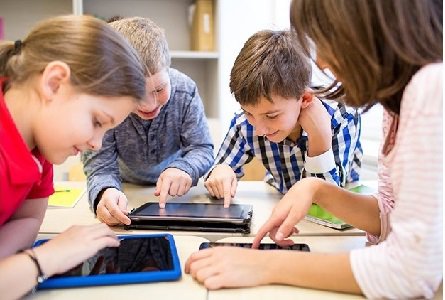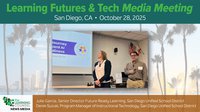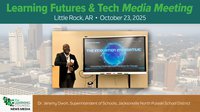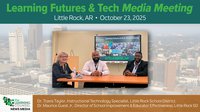Discussions about modernizing curriculum need to include solutions for keeping the students engaged and making sure they’re learning how to be critical, confident and creative—abilities they’ll need for success in the work-a-day world of the future.
With many school districts exploring the transition to digital curriculum, the number of solutions available to address these concerns have increased. One of those solutions is game-based learning. This approach to curriculum and teaching is particularly suited to take full advantage of the benefits of a digital curriculum.
What Is Game-Based Learning?
Games have been used as a learning tool for centuries. Chess was used to teach strategic thinking as far back as the Middle Ages, and the game of Kreigsspiel was invented in 1812 specifically to teach Prussian officers strategy. Beyond military strategy, the genesis of Kindergarten in the mid-1800s was Friedrich Fröbel’s ideas of learning through play.
The core concept behind game-based learning is teaching through repetition, failure and the accomplishment of goals. Video games are built on this principle. The player starts off slow and gains in skill until they’re able to skillfully navigate the most difficult levels. Games that are planned and designed well will offer enough difficulty to keep it challenging while still being easy enough for the player to win.
Game-based learning takes this same concept and applies it to teaching a curriculum. Students work toward a goal, choosing actions and experiencing the consequences of those actions. They actively learn and practice the right way to do things. The result is active learning instead of passive learning.
Flight simulators are a perfect example of the effectiveness of game-based learning. Pilots commonly use flight simulators during their training. They’re given very specific goals and practice until they can accomplish them. The result is much more effective than sitting through lectures and theory.
Game-Based Learning vs. Textbook Learning
The educational system has always been slow to change. On one hand, the fact that change is slow is a good thing, since it helps avoid the pitfalls of adopting education fads before they’re fully tested. On the reverse side, it leads to a system that is sluggish to respond to the rapidly changing technological world. The only way to increase that response rate is to drastically change the systemic approach to curriculum, which is no small task.
Keith Bockwoldt of Township HSD 214 outside Chicago talked recently with the Learning Counsel about the overall shift to digital curriculum that is happening. “Even the most advanced schools and districts implementing digital tools still have a long ways to go to achieve real transformation—it will be years,” he said. “When stepping into this arena and realizing just how many publishers and vendors are out there selling you curriculum and devices, with multiple logins and standards, it’s a huge challenge. But it’s a challenge we all must confront, understand and embrace.”
A big reason why change takes so long? Textbooks themselves. When a textbook is released, it contains all of the current information, educational methods, and theories as of when the textbook was sent to print, which is often at least a year before it arrives in schools. Since textbooks are meant to be used for years, there’s a substantial delay before curriculum can be changed and information updated.
Game-based learning is built to be adaptive from the beginning. During the production process the game is tested and adjusted to be a more effective learning tool. As new information comes out in the field or educational approaches are adjusted, the game can be changed to suit them. After the game is released, it can be updated with new information, approaches, and more. Games even have student-monitoring analysis tools which allow teachers to monitor the students so the game can be adjusted in future updates.
How a Learning Game is Built
When a student works on game-based learning, they’re probably just thinking that they’re having fun with a game, but there’s a lot that goes into crafting the game as a learning tool. The process begins with the curriculum and the core standards. Before the design even starts, a team of education, curriculum, and game experts decides on the exact lesson that will be taught to students.
“Learning games are built the same way a teacher builds a lesson plan.” says Suzi Wilczynski, founder and CEO of Dig It Games. “We start with a learning goal and then we work backwards.”
After that, the rest of the team is brought into play, and it’s no small venture. “A single game requires the work of skilled writers, game designers, artists, game architects, database developers, user interface specialists, and more on the core team alone,” Wilczynski say. “This team is expanded to bring in experts as needed for tasks like fact verification, curriculum building, testing, and consulting on user interface.”
It’s important for curriculum executives and their superintendents, as well as parents and teachers, to know exactly how much goes into a learning game when they’re assembling their own digital curriculum or working out their child’s education plan. “No stone is left unturned in the game development to create something that is rigorous, engaging, and aligned to standards,” stated Wilczynski.
Changing the Way Children Are Educated
Game-based learning is about more than giving students educational games like The Oregon Trail. It’s about changing the approach of students towards learning and the approach of learning towards students. The goal is for students to enjoy the process of learning itself.
As a student learns through game-based learning, they gain much more ownership of the material, which improves retention. The combination of different approaches and goal-based learning addresses all of the learning styles at the same time. No matter what a student’s primary, secondary, or tertiary learning style, a game can address them. Games can even combine multiple subjects into a single game, creating a versatile learning tool.
Learning games also provide students a safe environment for failure. It can be hard for students, especially adolescents, to fail in a public setting like a classroom. Games give them a chance to try out new things. If they fail in the environment of the game, then they can simply try again and learn from their mistakes. Instead of education based on rote memorization, students learn through experimentation and trial and error.











